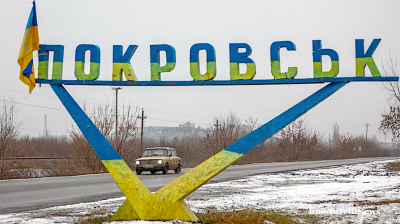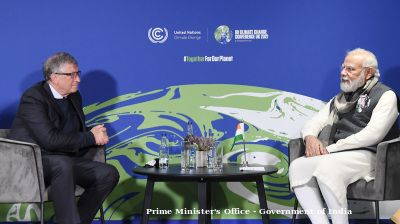Russia’s Burevestnik nuclear-powered cruise missile has no analogues in the world, Russian President Vladimir Putin said on October 26, as the Kremlin escalates the unfolding missile arms race with Ukraine another notch.
Wearing military fatigues, Putin made the comments during a visit to one of the Russian command posts of the joint group of forces and held a meeting with Chief of the General Staff Valery Gerasimov and commanders of the battlegroups involved in the war in Ukraine.
"I have a report from the industrial bodies, and in general I am familiar with the estimates of provided by the defence ministry. It's a unique product that no one else in the world possesses," the Russian president said.
"I remember quite well when we announced that we were in the development stage of such weapons and even high-level experts told me that it worthy objective indeed, but in the historical short term was unrealisable. I reiterate that this opinion was voiced by high-class experts," Putin added.
Russia successfully tested the nuclear-powered and nuclear-capable Burevestnik cruise missile, which Putin says can pierce any defence shield, and will now deploy the weapon.
The test was part of a nuclear drill last week and is designed to send a message to Washington that is toying with the idea of supplying Ukraine with equally powerful Tomahawk cruise missiles. In his remarks in a televised meeting, Putin said that Russia will “never bow to pressure” from the West over the war in Ukraine as US President Donald Trump hardened his line against Russia again last week, imposing the first sanctions on Russia since he took office in January with oil sanctions on Russia’s two biggest oil companies.
Gerasimov, a close Putin ally, told Putin that the 9M730 Burevestnik (Storm Petrel) - dubbed the SSC-X-9 Skyfall by Nato - flew 14,000 km and was in the air for about 15 hours during a test on October 21. Putin called it "invincible" against current and future missile defences, with an almost unlimited range and unpredictable flight path.
The Burevestnik was first mentioned in 2018, according to Reuters, when it was cast in response to moves by the United States to build a missile defence shield after Washington in 2001 unilaterally withdrew from the 1972 Anti-Ballistic Missile Treaty, and to enlarge the Nato military alliance.
Ukraine's missiles
Ukraine has been throwing its efforts into developing missiles to counter Russia’s overwhelming advantage in long-range cruise and ballistic missile production. It has already developed the Neptune sea-launched, which was used early in the war to sink Russia’s Black Sea flagship, the Moskva in April 2022. Since then the missile has been adapted for land use.
Ukraine also developed the Palyanytsia cruise missile, but it has limited range and has since been superseded by the powerful and long-range Flamingo cruise missile which has a 1,200kg payload and range of more than 3,000km that can threaten strategic targets deep inside Russia as well Moscow itself.
Ukraine developed the missile, which uses generic engines produced by local aviation plant Motor Sich, in only nine months. As a result, the cost of the missile is a very affordable $400,000 each and the factory is already producing seven a day with the hope of rapidly increasing the output.
For comparison, Russia produced 1,200 missiles of various sophistication last year, but with heavy investment, the Kremlin says that will increase to 2,500 this year.
While the Flamingo is a welcome addition to Ukraine’s arsenal, and goes someway to compensating for the US decision to provide Kyiv with its powerful Tomahawk missiles. Ukraine’s Western allies remain reluctant to send Ukraine really powerful missiles that can fly deep into Russian territory as part of its “some, but not enough” escalation containment strategy of support. Likewise, German Chancellor Friedrich Merz has refused to supply Ukraine with its powerful Taurus cruise missile. France and the US have sent their Storm Shadow missiles to Ukraine, but as those went out of production 15 years ago, the stockpile has almost been depleted.
Russia ahead in missile development
For its part, Russia remains well ahead in missile development in the unfolding missile war it launched this summer. In addition to the Burevestnik, it has also developed the Oreshnik cruise missile that can hit any city in Western Europe as well as a family of new hypersonic missiles which Putin showcased in his 2018 state of the nation speech, which he claims the West has no defences against.
At the other end of the spectrum, Russia has upgraded its FAB glide bombs – WWII vintage heavy gravity bombs that can carry a devastating payload of up to 3,000kg of explosives. More recently, the Armed Forces of Russia (AFR) have put an improved FAB 500 glide bomb into service that is jet propelled, which has significantly increased its range.
Military analysts say the shortcomings of the Flamingo include the lack of satellite navigation system, which makes targeting inaccurate, and sophisticated defence capabilities. According to reports, the AFU has fired several Flamingos at Russia, but several were shot down by Russian surface-to-air defence systems.
And Ukraine has little in the way of air defences to protect itself against Russian-made missiles, almost entirely reliant on US-made Patriot missiles, where after months of exchanges, ammo supplies are running low. In recent months, the AFR has changed tactics and is flying waves of drones against key military and energy assets to deplete air defence measures before firing a salvo of missiles at the target, which has caused significant damage.
As bne IntelliNews reported, both sides have been targeting energy assets this summer with the AFU targeting Russian oil refineries, but the jury remains out on who is doing the most damage as winter looms. Ukraine is facing a dark and cold winter, but Russia’s size is its Achilles’ heel as it is simply too big to be able to protect important assets spread across its vast territory and most of its best air defence systems are deployed in Ukraine.
News

Russia claims to surround Pokrovsk
Russia’s chief of the general staff Valery Gerasimov triumphantly reported to Putin that 31 Ukrainian battalions have been encircled in Pokrovsk and 18 battalions in Kupyansk, the hottest spot in the war.
.jpg)
Brazil and US to start urgent tariff negotiations after Trump-Lula meeting
Brazilian President Luiz Inácio Lula da Silva and US President Donald Trump have agreed to start immediate negotiations on tariffs and sanctions imposed by Washington, following a meeting in Malaysia that sought to ease trade tensions.

Cambodia and Thailand agree peace deal
Thailand and Cambodia have agreed a peace deal to mark the end of a conflict earlier in the year as Cambodian Prime Minister Hun Manet and Thai Prime Minister Anutin Charnvirakul attended a signing ceremony overseen by US President Donald Trump.

Trump would like to meet North Korea’s Kim Jong Un during Asia trip
The prospect of renewed diplomacy between Washington and Pyongyang has lingered since Kim’s remarks last month suggesting a willingness to speak to the outside world.



